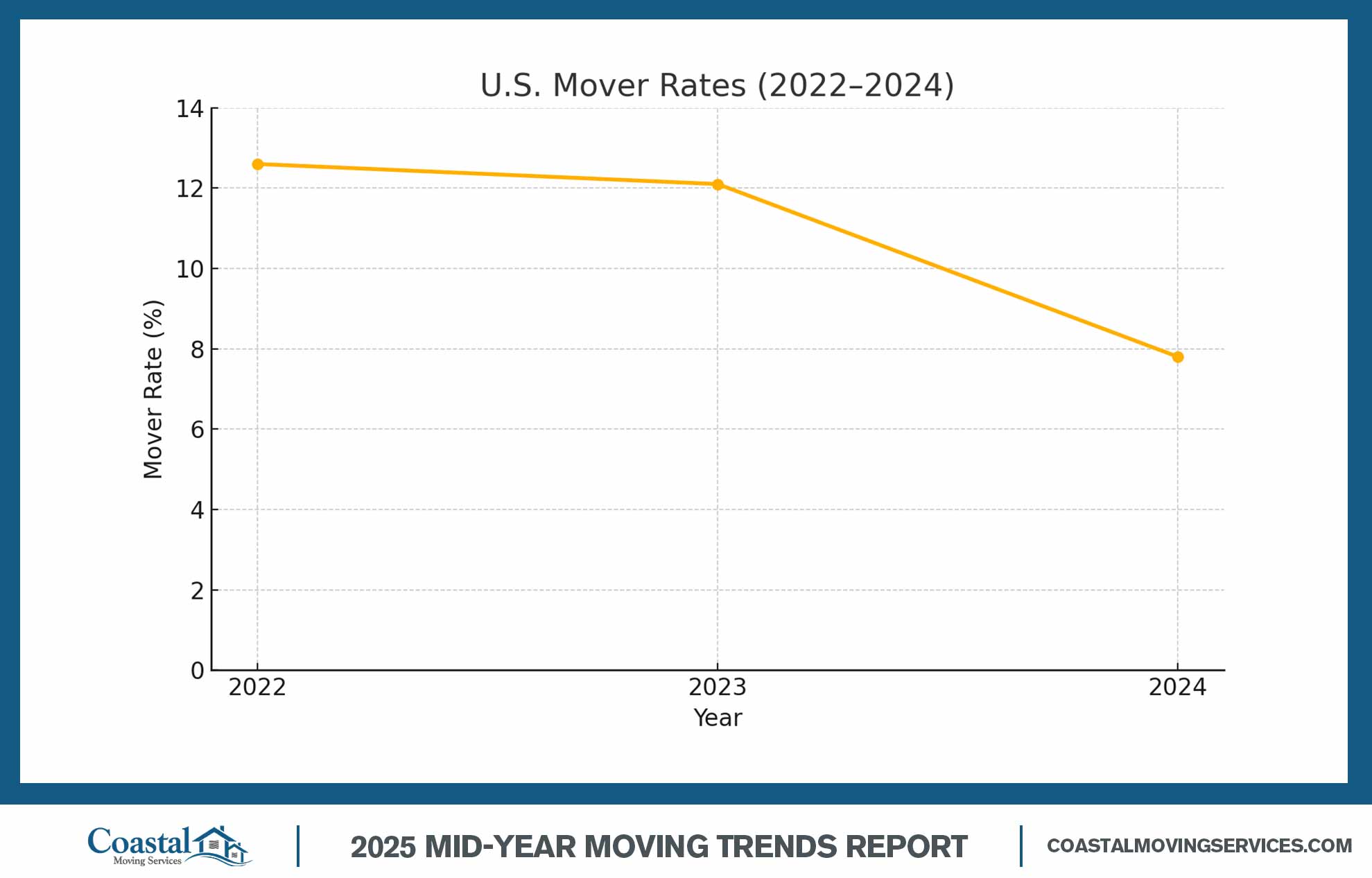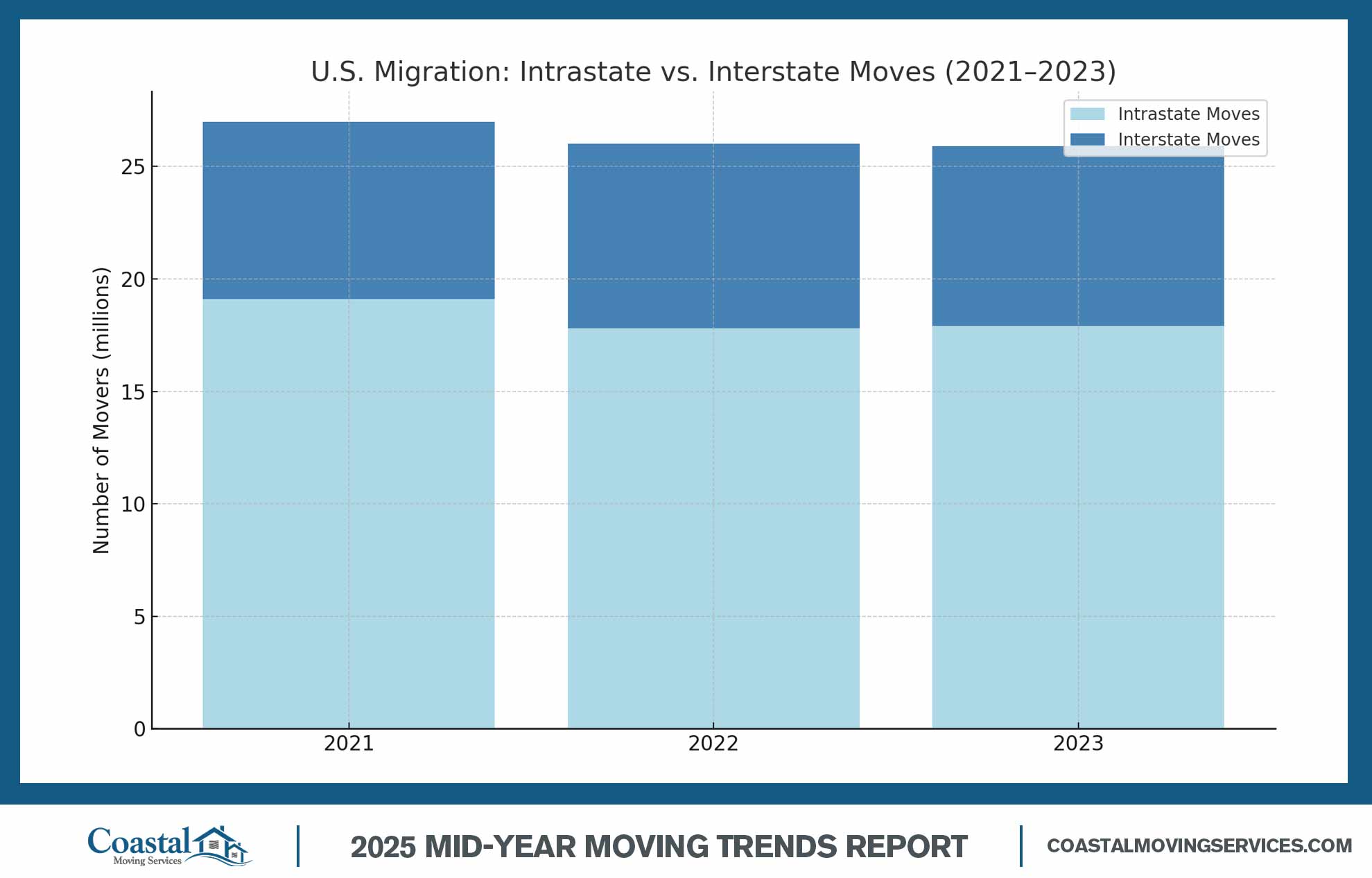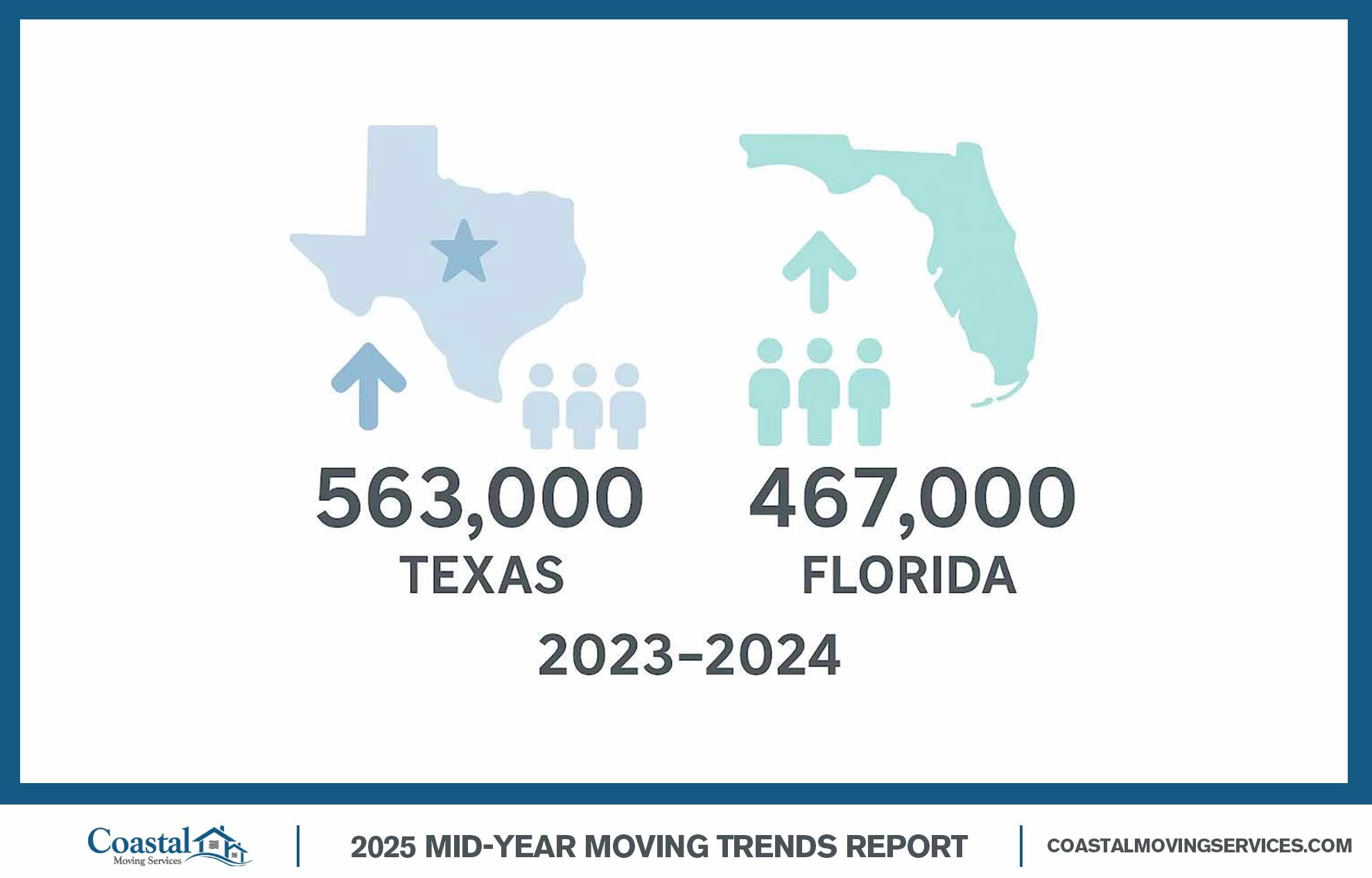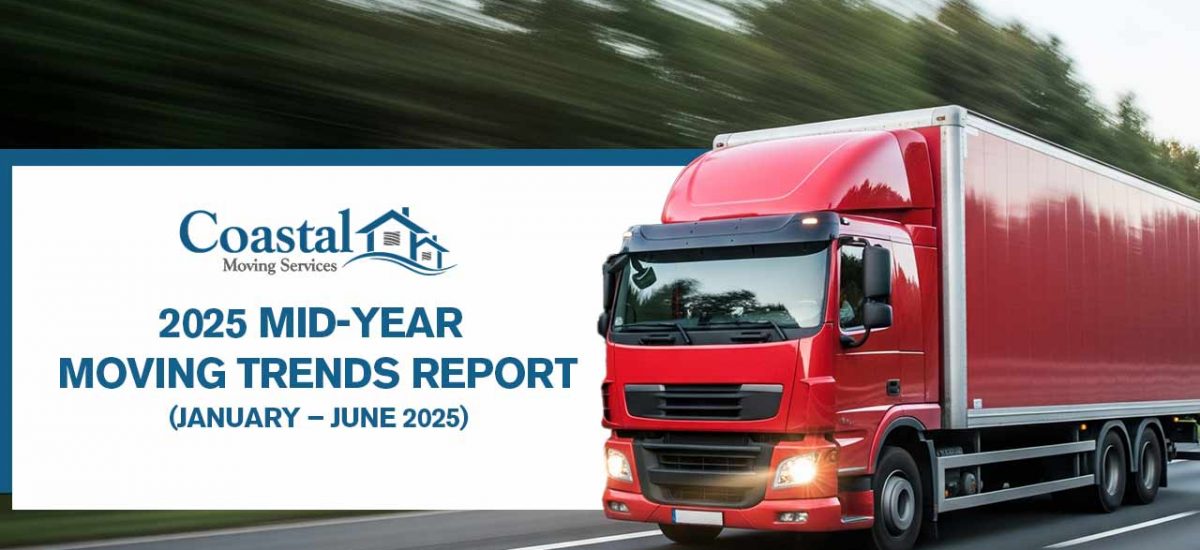The first half of 2025 has revealed significant moving trends in how Americans are relocating. As a leading moving service, Coastal Moving Services has analyzed the latest data on who’s moving, where they’re going, and why. This mid-year report covers nationwide moving statistics, long-distance vs. local patterns, popular destinations, reasons behind moves, and the growing role of storage.
Planning a move in 2025? Call us at +1-334-659-1878 for trusted moving assistance.
 However, 2025 shows early signs of a rebound. Economists note that as inflation eases and mortgage interest rates decline, Americans are regaining confidence to relocate. New home construction is increasing, and industry experts are “cautiously optimistic” that moving activity will rise in 2025 after the recent lull. The moving and storage industry, contributing over $20 billion annually and supporting approximately 120,000 jobs nationwide, makes even a modest uptick in moves significant. The mid-year outlook suggests U.S. mobility is inching upward as financial barriers slowly lift.
However, 2025 shows early signs of a rebound. Economists note that as inflation eases and mortgage interest rates decline, Americans are regaining confidence to relocate. New home construction is increasing, and industry experts are “cautiously optimistic” that moving activity will rise in 2025 after the recent lull. The moving and storage industry, contributing over $20 billion annually and supporting approximately 120,000 jobs nationwide, makes even a modest uptick in moves significant. The mid-year outlook suggests U.S. mobility is inching upward as financial barriers slowly lift.


The Mountain West and Midwest, including places like Boise, ID, and certain Ohio cities, are also attracting movers seeking affordable, family-friendly communities. Census data shows 47 states (and D.C.) gained population in 2024, while only three saw slight declines, indicating growth even in traditionally stagnant regions.
More scoped article can be viewed also here; Top Cities People Are Moving to in 2025
4.9/5 AVERAGE RATING
Storage is now a core part of the moving experience. Some downsize to smaller homes, needing storage for excess items, while others use it while settling into new cities. Even as moving rates dipped, self-storage usage hit record highs in 2023. Stabilizing prices in 2025 make storage more accessible, and flexible solutions like traditional units or mobile containers provide breathing room during transitions. This moving-and-storage trend is expected to grow through 2025 and beyond.
U.S. Moving Volume: Historic Lows with Signs of Rebound
American mobility remains near historic lows, with roughly 8% of Americans (about 26 million people) moving to a new home each year; half the rate seen in the 1960s. In 2024, an estimated 25.9 million Americans moved (7.8% of the population), continuing the record-low moving rates observed in 2023, where the mover rate was 7.6%, down slightly from 7.8% in 2022. High housing costs and economic uncertainty kept many families in place through 2023. However, 2025 shows early signs of a rebound. Economists note that as inflation eases and mortgage interest rates decline, Americans are regaining confidence to relocate. New home construction is increasing, and industry experts are “cautiously optimistic” that moving activity will rise in 2025 after the recent lull. The moving and storage industry, contributing over $20 billion annually and supporting approximately 120,000 jobs nationwide, makes even a modest uptick in moves significant. The mid-year outlook suggests U.S. mobility is inching upward as financial barriers slowly lift.
However, 2025 shows early signs of a rebound. Economists note that as inflation eases and mortgage interest rates decline, Americans are regaining confidence to relocate. New home construction is increasing, and industry experts are “cautiously optimistic” that moving activity will rise in 2025 after the recent lull. The moving and storage industry, contributing over $20 billion annually and supporting approximately 120,000 jobs nationwide, makes even a modest uptick in moves significant. The mid-year outlook suggests U.S. mobility is inching upward as financial barriers slowly lift.
Local Moves vs. Long-Distance Moves
Most Americans who move stay close to home. The vast majority of relocations are local, often within the same city or state, while interstate moves remain a smaller segment. According to the latest Census data, only about 2.3% of the U.S. population moved to a different state in 2023, translating to roughly 7.7 – 8 million interstate movers. Over 75% of movers stayed within their state, typically within a short distance. This trend reflects moves driven by local changes, such as finding a new home in the same area or relocating for a nearby job or family need.
Rising Long-Distance Migration
Long-distance migration is increasing, with state-to-state moves rising from 7.9 million in 2021 to 8.2 million in 2022. Remote work opportunities and shifting housing costs have encouraged more people to consider out-of-state moves for better lifestyles or affordability. However, local moves still dominate moving company schedules, especially during high-cost economic periods.Seasonal Moving Trends
Summer 2025 is expected to follow the typical seasonal spike, with May through August as the peak moving season. Historically, about 41% of all moves occur during these months, with June being the busiest, as families take advantage of school breaks and good weather. The first half of 2025 likely saw increasing activity leading into this summer rush.Migration Patterns: Who’s Moving Where?
In 2025, Americans are moving toward affordable Sun Belt and Southeastern states and away from high-cost coastal hubs, continuing the pandemic-era population shift. States with warm climates, lower taxes, and strong job markets are seeing the largest influx of new residents.Top Destination States
Top growth states in 2025 include Texas, Florida, North Carolina, Tennessee, South Carolina, and Georgia. These states offer affordable housing, booming economies, and quality-of-life appeal, such as milder winters and ample space, attracting young professionals and retirees alike. The U.S. Census Bureau confirms the South as the fastest-growing U.S. region, adding more people in 2024 than all other regions combined. Texas gained about 563,000 new residents and Florida gained 467,000 between 2023 and 2024, leading the nation in population growth. North Carolina’s population surpassed 11 million after a 1.5% jump, and South Carolina saw one of the highest net migration gains.
States Losing Population
High-cost states like California, New York, New Jersey, Illinois, and Massachusetts are experiencing net outbound migration. These states, home to expensive real estate and major metro areas, have seen thousands of residents leave for more affordable regions. California, despite having the largest population, lost a net 239,000 people to other states in 2024. New York and Illinois also continue to see more departures than arrivals.Shifting Urban Trends
Cities like New York City, San Francisco, and Los Angeles are among the top “exit” cities in 2025, with more residents moving out than in, driven by high rents, home prices, and the flexibility of remote work. Meanwhile, the Southeast is thriving, with mid-sized cities like Myrtle Beach, SC; Raleigh, NC; Greenville, SC; Knoxville, TN; and Huntsville, AL surging in popularity for their lower costs and outdoor amenities.| Category | Details |
|---|---|
| Top Destination (2025) | Myrtle Beach, SC – popular for “vacation-like” feel, affordability, and outdoors |
| Rising Medium-Size Cities | Raleigh, NC – Greenville, SC – Knoxville, TN – Huntsville, AL |
| Gaining Popularity (Regions) | Mountain West, Midwest |
| Notable Cities | Boise, ID |
| Population Shift (2024) | 47 states + D.C. gained population Only 3 states saw slight declines |
| Migration Trend (2025) | Movement from expensive coastal metros to lower-cost Southern and interior regions |
Why Are People Moving in 2025?
The motivations behind 2025 moves reflect economic and lifestyle priorities. Affordability is the top driver, with 50% of Americans in a recent survey citing a desire to move for a lower cost of living, driven by high home prices and past mortgage rate spikes. States offering cheaper housing, lower taxes, and strong job markets attract these cost-conscious movers.Employment and Remote Work
Employment opportunities are a key factor, with many moving for new jobs or to tap into growing regional economies. Fast-growing metro areas in the South and Mountain West offer ample jobs and lower unemployment. The rise of remote and hybrid work has also shifted trends, allowing Americans to choose locations based on lifestyle goals, like safer neighborhoods, better schools, or proximity to nature, rather than employer proximity. This flexibility has driven migrations to smaller cities and rural areas.Quality of Life and Climate
Quality of life, particularly regarding climate and environment, is playing an increasingly significant role in relocation decisions. In 2024, moves primarily driven by a desire for better weather or fewer natural disasters saw a dramatic increase, as many Americans, having endured years of wildfires, hurricanes, and winter storms, are seeking more agreeable and safer climates. While retirees continue to favor sunnier locales, even younger families are now factoring climate risk into their choices of where to settle. Other personal reasons for moving, such as proximity to family, pursuing higher education, or downsizing in retirement, remain consistent but are often secondary to these evolving climate-related priorities. Overall, 2025’s movers are largely seeking better housing options, economic relief, and lifestyle improvements. As one moving industry report summarized, “employment opportunities, housing affordability, climate, and quality of life” are the big themes influencing Americans’Moving & Storage Trends in 2025
Moving and storage trends are closely linked. In 2025, more Americans are using storage solutions to manage timing gaps or downsize living spaces, contributing to a booming self-storage industry.Booming Self-Storage Industry
As of 2024, an estimated 10.2% of U.S. households rent a self-storage unit, up from 9.3% a few years earlier, marking an all-time high. This reflects the growing need to store furniture and goods during moves or life changes. Even as moving rates hit lows in 2023, storage demand remains above pre-2020 levels. Nationwide, storage construction is expanding, with millions of square feet of new space added in 2025 to meet demand.Rise of Portable Moving Containers
Portable moving containers, like PODS, are gaining popularity, blending moving and storage by allowing customers to pack belongings into secure containers for transport or storage. Surveys show about 16% of Americans would choose containers for their move, valuing the flexibility of loading at their own pace. Coastal Moving Services has noted increased use of containers for transitions, such as gaps between homes or renovations. The convenience of driveway-delivered storage units has resonated widely.long distance moves
as low as $1748
Long-distance moving all across the United States. Experienced and insured, residential and commercial.
Quick Free Quote
4.9/5 AVERAGE RATING
5/5










